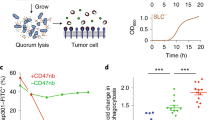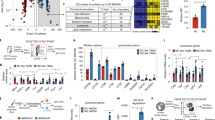Abstract
Cancer vaccines typically depend on cumbersome and expensive manipulation of cells in the laboratory, and subsequent cell transplantation leads to poor lymph-node homing and limited efficacy. We propose that materials mimicking key aspects of bacterial infection may instead be used to directly control immune-cell trafficking and activation in the body. It is demonstrated that polymers can be designed to first release a cytokine to recruit and house host dendritic cells, and subsequently present cancer antigens and danger signals to activate the resident dendritic cells and markedly enhance their homing to lymph nodes. Specific and protective anti-tumour immunity was generated with these materials, as 90% survival was achieved in animals that otherwise die from cancer within 25 days. These materials show promise as cancer vaccines, and more broadly suggest that polymers may be designed to program and control the trafficking of a variety of cell types in the body.
This is a preview of subscription content, access via your institution
Access options
Subscribe to this journal
Receive 12 print issues and online access
$259.00 per year
only $21.58 per issue
Buy this article
- Purchase on Springer Link
- Instant access to full article PDF
Prices may be subject to local taxes which are calculated during checkout





Similar content being viewed by others
References
Banchereau, J. & Steinman, R. M. Taking dendritic cells into medicine. Nature 49, 419–426 (2007).
Gilboa, E. Dendritic cell based vaccines. J. Clin. Invest. 117, 1195–1203 (2007).
Banchereau, J & Steinman, R. M. Dendritic cells and the control of immunity. Nature 392, 245–252 (1998).
Schuler, G., Schuler-Thurner, B. & Steinman, R. M. The use of dendritic cells in cancer immunotherapy. Curr. Opin. Immunol. 15, 138–147 (2003).
US National Institutes of Health. <http://clinicaltrials.gov> (2007).
Kleindienst, P. & Brocker, T. Endogenous dendritic cells are required for amplification of T cell responses induced by dendritic cell vaccine in vivo. J. Immunol. 170, 2817–2823 (2003).
Celluzzi, C. M., Mayordomo, J. I., Storkus, W. J., Lotze, M. T. & Falo, L. D. Jr. Peptide- pulsed dendritic cells induce antigen-specific, CTL-mediated protective tumor immunity. J. Exp. Med. 183, 283–287 (1996).
Jenne, L., Arrighi, J. F., Jonuleit, H., Saurat, J. H. & Hauser, C. Dendritic cells containing apoptotic melanoma cells prime human CD8+T cells for efficient tumor cell lysis. Cancer Res. 60, 4446–4452 (2000).
Mellman, I. & Steinman, R. M. Dendritic cells: Specialized and regulated antigen processing machines. Cell 106, 255–8 (2001).
Sozzani, S. et al. Differential regulation of chemokine receptors during dendritic cell maturation: A model for their trafficking properties. J. Immunol. 161, 1083–1086 (1998).
Yanagihara, S., Komura, E., Nagafune, J., Watari, H. & Yamaguchi, Y. EB1/CCR7 is a new member of dendritic cell chemokine receptor that is upregulated upon maturation. J. Immunol. 161, 3096–3102 (1998).
Dieu, M. C. et al. Selective recruitment of immature and mature dendritic cells by distinct chemokines expressed in different anatomic sites. J. Exp. Med. 188, 373–386 (1988).
Dranoff, G. et al. Vaccination with irradiated tumor cells engineered to secrete murine granulocyte macrophage colony-stimulating factor stimulates potent, specific, and long-lasting anti-tumor immunity. Proc. Natl Acad. Sci. USA 90, 3539–3543 (1993).
Randolph, G. J., Ochando, J. & Partida-Sanchez, S. Migration of dendritic cell subsets and their precursors. Annu. Rev. Immunol. 26, 293–316 (2008).
Klinman, D. M. Immunotherapuetic uses of CpG oligodeoxynucleotides. Nature Rev. Immunol. 4, 249–58 (2004).
Okano, F, Merad, M, Furumoto, K & Engleman, E. G. In vivo manipulation of dendritic cells overcomes tolerance to unmodified tumor-associated self antigens and induces potent antitumor immunity. J. Immunol. 174, 2645–52 (2005).
Sheridan, M. H., Shea, L. D., Peters, M. C. & Mooney, D. J. Bioabsorbable polymer scaffolds for tissue engineering capable of sustained growth factor delivery. J. Control Release 64, 91–102 (2000).
Richardson, T. P., Peters, M. C., Ennett, A. B. & Mooney, D. J. Polymeric system for dual growth factor delivery. Nature Biotech. 1029–1034 (2001).
Griffith, L. G. Emerging design principles in biomaterials and scaffolds for tissue engineering. Ann. NY Acad. Sci. 961, 83–95 (2002).
Ali, O. A. & Mooney, D. J. Cell Transplantation from Laboratory to Clinic 591–609 (Elsevier, 2006).
Disis, M. L. Clinical use of subcutaneous G-CSF or GM-CSF in malignancy. Oncology 19, 5–9 (2005).
Harris, L. D., Kim, B. S. & Mooney, D. J. Open pore biodegradable matrices formed with gas foaming. J. Biomed. Mater. Res. 42, 396–402 (1998).
Thomas, W. R., Edwards, A. J., Watkins, M. C. & Asherson, G. L. Distribution of immunogenic cells after painting with the contact sensitizers fluorescein isothiocyanate and oxazolone. Different sensitizers form immunogenic complexes with different cell populations. Immunobiology 39, 21–27 (1980).
Fidler, I. J. Biological behavior of melanoma cells correlated to their survival in vivo. Cancer Res. 35, 218–234 (1975).
Huang, Y. C., Connell, M., Park, Y., Mooney, D. J. & Rice, K. G. Fabrication and in vitro testing of polymeric delivery system for condensed DNA. J. Biomed. Mater. Res. 67, 1384–1392 (2003).
Krieg, A. M. Development of TLR9 agonists for cancer therapy. J. Clin. Invest. 17, 1184–94 (2007.).
Kanzler, H., Barrat, F. J., Hessel, E. M. & Coffman, R. L. Therapeutic targeting of innate immunity with Toll-like receptor agonists and antagonists. Nature Med. 13, 552–559 (2007).
Kapsenberg, M. Dendritic-cell control of pathogen-driven T-cell polarization. Nature Rev. Immunol. 12, 984–93 (2003).
De Palma, R. et al. Therapeutic effectiveness of recombinant cancer vaccines is associated with a prevalent T-cell receptor usage by melanoma-specific CD8 T lymphocytes. Cancer Res. 8068–8076 (2004).
Okamoto, T. et al. Anti-tyrosinase-related protein-2 immune response in vitiligo patients and melanomapatients receiving active-specific immunotherapy. J. Invest. Dermatol. 111, 1034–1039 (1998).
Richards, J. M., Mehta, N., Ramming, K. & Skosey, P. Sequential chemoimmunotherapy in the treatment of metastatic melanoma. J. Clin. Oncol. 10, 1338–1343 (1992).
Rosenberg, S. A. & White, D. E. Vitiligo in patients with melanoma: Normal tissue antigens can be targets for cancer immunotherapy. J. Immunother. Emphasis Tumor Immunol. 19, 81–84 (1996).
Overwijk, W. W. et al. Autoimmunity after reversal of a functionally tolerant state of self-reactive CD8+ T cells. J. Exp. Med. 4, 569–80 (2003).
Fischer, M. A. Implanon: A new contraceptive implant. J. Obstet. Gynecol. Neonatal. Nurs. 37, 361–8 (2008).
Cohen, S., Yoshioka, T., Lucarelli, M., Hwang, L. H. & Langer, R. Controlled delivery systems for proteins based on poly(lactic/glycolic acid) microspheres. Pharm. Res. 8, 713–720 (1991).
Acknowledgements
We are grateful to the Bauer research centres at Harvard University for assistance in NanoDrop measurements of nucleotide content. We thank B. Tilton for technical assistance with flow cytometry. The project has been made possible by NIH financial support (NIH R01 DE013033) and internal financial support at Harvard University to D.J.M.
Author information
Authors and Affiliations
Contributions
The experiments were designed by O.A., D.J.M. and G.D. and carried out by O.A., N.H. and L.C. The manuscript was written by O.A. and D.J.M. The principal investigator is D.J.M.
Corresponding author
Supplementary information
Supplementary Information
Supplementary Information (PDF 372 kb)
Rights and permissions
About this article
Cite this article
Ali, O., Huebsch, N., Cao, L. et al. Infection-mimicking materials to program dendritic cells in situ. Nature Mater 8, 151–158 (2009). https://doi.org/10.1038/nmat2357
Received:
Accepted:
Published:
Issue Date:
DOI: https://doi.org/10.1038/nmat2357
This article is cited by
-
Adoptive T cell transfer and host antigen-presenting cell recruitment with cryogel scaffolds promotes long-term protection against solid tumors
Nature Communications (2023)
-
Targeted modulation of immune cells and tissues using engineered biomaterials
Nature Reviews Bioengineering (2023)
-
Bio-adhesive Macroporous Hydrogels for In Situ Recruitment and Modulation of Dendritic Cells
Cellular and Molecular Bioengineering (2023)
-
Emerging strategies for biomaterial-assisted cancer immunotherapy
Korean Journal of Chemical Engineering (2022)
-
Auto-antigen and Immunomodulatory Agent–Based Approaches for Antigen-Specific Tolerance in NOD Mice
Current Diabetes Reports (2021)



